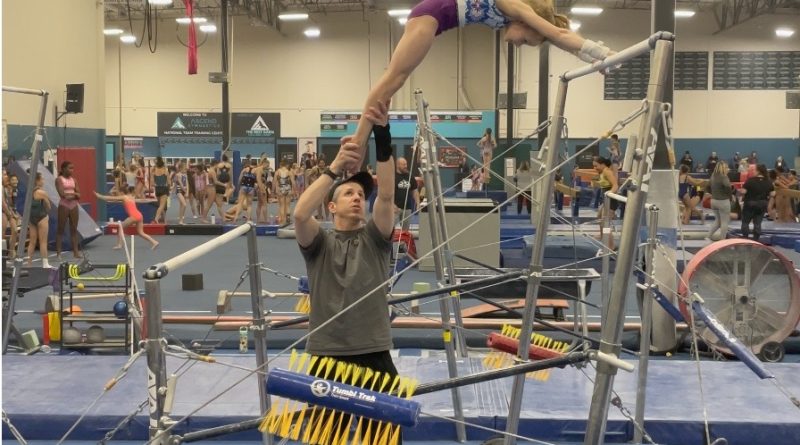Tap Swings
The tap swing is one of the most fundamental building blocks in gymnastics. Take the time to try and maximize quality early in the process. The understanding of how to accelerate the feet at the right time to create giants, dismounts, release moves is vital. We are never teaching a skill for it to be the end of the learning process. Our goal is to be creating the current skill to be a building block for the next tier of skills to be built upon. The giant on bars will only be good if the athlete can do a quality tap swing.
Tap Swings - Spotted Back Side
Spotting the back side and helping the gymnast pause at the top of each tap swing can be very beneficial. This helps them find the correct shapes, pressure, and form on the back of the swing. The pause may need to be longer or shorter depending on the proficiency of the gymnast. As you can see in this video, this athlete is very proficient at tap swings and therefore there is not as much need to wait and correct the positions or form on each swing. The way I am spotting this drill is to allow for quality toe point and leg extension throughout.
Tap Swings - Spotted the Front Side
We believe there is a ton of value in spotting the front side of the tap swing. Often when athletes are allowed to learn and train tap swings by themselves too often, they develop the habit of extending the hips open too early. This creates a lack of inversion and rise. It also cements in them that the toes go forward rather than up and will most times create issued when taking the next step towards baby giants and giants. Notice the wrist grab for each back swing and the shoulder spot on the front side. The spot of the shoulders in front is to support the athlete so they don't feel like they will collapse their shape at the top and crumble back to the bar. The wrist spot on each back swing is to be as safe as possible. When spotting the front, they might feel as though they get bigger back swings and need help learning how to handle that back swing consistently.
Hanging Tap Swing Shape Changes
These hanging tap swing shape changes are good for making sure the athletes are trying to shape change through their chest and hips together and not simply trying to pike from the hips alone and arch lower back only. There are slow versions and fast versions of these shape changes. This fast version is just to reinforce that you can shape change with quality positions even at a rapid pace.
Low Bar - Hop Drags
This drill really requires no set up and simply helps the gymnast feel the toes pause and the hips lead forward. They really get to feel the full body stretch through the bottom that will be a power creator for the front side of the tap swing/giant/dismount/etc.
Porcupine Pad Tap Swings
As you can see with this athlete... if they are tiny, you can introduce and create excellent tap swings on a low bar. Using the porcupine Pad, you can help the gymnast create the timing of toes down first at the initiation of downswing, then opening their hips down under the bar and kicking on the front side. Many young athletes will start their extension immediately from the top of the back swing and this results in an early tap at the bottom and an inefficient tap swing.

